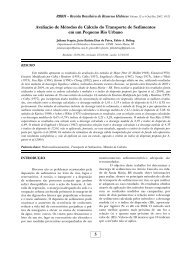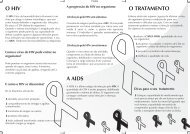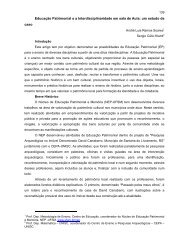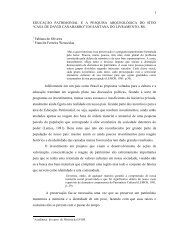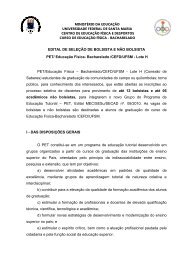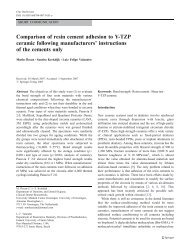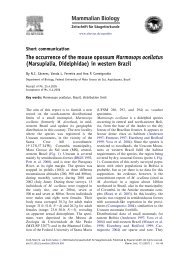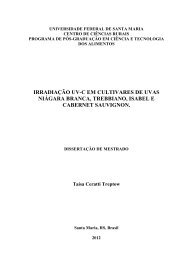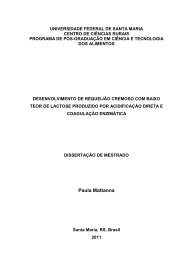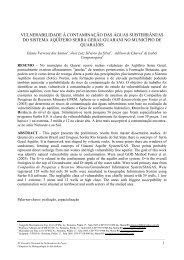DESENVOLVIMENTO E CARACTERIZAÇÃO FÃSICO ... - UFSM
DESENVOLVIMENTO E CARACTERIZAÇÃO FÃSICO ... - UFSM
DESENVOLVIMENTO E CARACTERIZAÇÃO FÃSICO ... - UFSM
You also want an ePaper? Increase the reach of your titles
YUMPU automatically turns print PDFs into web optimized ePapers that Google loves.
57<br />
The extraction of minor volatile compounds of jelly palm wine was conducted using a solid<br />
phase microextraction technique according to Bernardi et al., (2013). The volatile compounds were<br />
extracted using a DVB/CAR/PDMS fiber; 10 mL of jelly palm wine was transferred to a 20 ml<br />
glass vial added to 3g of NaCl and 10 µl of 3-octanol (82.2 mg/l internal standard solution). Time<br />
of extraction was 45 minutes preceded for 5 min of equilibrium at 35 °C under constant stirring<br />
(500 rpm).<br />
The analysis of the volatile compounds was conducted using a Varian 3400 Star gas<br />
chromatograph equipped with a Split/Splitless injector and a flame ionization detector (GC-FID).<br />
A ZB-WAX plus capillary column (60 m × 0.25 mm × 0.25 μm film thickness) (Phenomenex, CA,<br />
USA) was used. The temperature of the injector and detector was set to 230 and 250 °C<br />
respectively. The oven temperature was held at 35 °C for 2 min and raised from 35 °C to 80 °C at<br />
4 °C/min, then programmed to run from 80 °C to 200 °C at 30 °C/min remaining at 200 °C/min for<br />
5 min. Carrier gas was hydrogen at an initial flow rate of 2 ml/min (constant pressure of 30 psi).<br />
The relative concentrations of the investigated compounds were calculated by relating the area of<br />
the internal standard to the area of the compound of interest. Response factor between internal<br />
standard and analytes was assumed as one.<br />
Volatile compounds were identified in a Shimadzu QP2010 gas chromatograph coupled to a<br />
mass spectrometer GC/MS. GC conditions were the same as those used for the GC-FID<br />
chromatographic analysis. Helium was the carrier gas at a flow rate of 2 ml/min. MS was operated<br />
in electron ionization mode (EI) at 70 eV, scanning from 35 to 350 m/z. The volatile compounds<br />
were identified by comparing their mass spectra to those of commercial spectra databases (Wiley,<br />
NIST05) and by comparing experimental retention index (RI) with the literature. Some compounds<br />
were positively identified by injecting the authentic standards into the GC-FID and GC/MS<br />
systems.<br />
2.5 Sensory Analysis<br />
The final beverages were evaluated by 40 panelists, males and females, (staff and students<br />
of the Federal University of Santa Maria - <strong>UFSM</strong>). The panelists were selected for participation on<br />
the basis of their preference for wines, interest, and availability. Refrigerated (10 °C) samples of<br />
20 ml were served in clear glasses with a volume of 50 ml; these were marked with three digit



